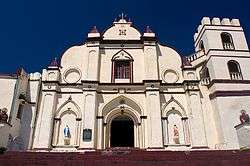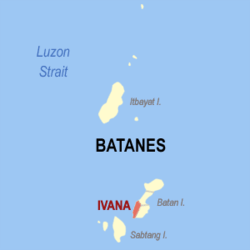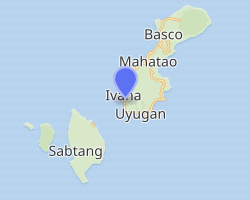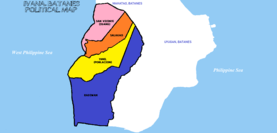Ivana, Batanes
Ivana, officially the Municipality of Ivana (Ivatan: Kavahayan nu Ivana; Tagalog: Bayan ng Ivana), is a 6th class municipality in the province of Batanes, Philippines. According to the 2015 census, it has a population of 1,327 people.[3]
Ivana | |
|---|---|
| Municipality of Ivana | |
 | |
 Seal | |
 Map of Batanes with Ivana highlighted | |
OpenStreetMap 
| |
.svg.png) Ivana Location within the Philippines | |
| Coordinates: 20°22′N 121°55′E | |
| Country | |
| Region | Cagayan Valley (Region II) |
| Province | Batanes |
| District | Lone District |
| Barangays | 4 (see Barangays) |
| Government | |
| • Type | Sangguniang Bayan |
| • Mayor | Leonardo V. Hostallero |
| • Vice Mayor | Romeo Emilio E. Fidel |
| • Congressman | Ciriaco B. Gato Jr. |
| • Electorate | 1,122 voters (2019) |
| Area | |
| • Total | 16.54 km2 (6.39 sq mi) |
| Population (2015 census)[3] | |
| • Total | 1,327 |
| • Density | 80/km2 (210/sq mi) |
| • Households | 357 |
| Economy | |
| • Income class | 6th municipal income class |
| • Poverty incidence | 18.27% (2015)[4] |
| • Revenue (₱) | 31,188,431.55 (2016) |
| Time zone | UTC+8 (PST) |
| ZIP code | 3902 |
| PSGC | |
| IDD : area code | +63 (0)78 |
| Climate type | tropical monsoon climate |
| Native languages | Ivatan Tagalog Ilocano |
| Website | www |
History
Ivana is one of the three major pueblos of Batanes in the first half of the 19th century, alongside Basco and Marigatao.[5] A mission was opened in the late 18th century with evangelization described as successful mainly due to the baptism of seven of the nine principals of Ivana.[6]
In 1789, Joaquin del Castillo became the third governor of Batanes. Measures were put in place to ensure that all the natives including unbaptized ones respect and obey the law by means of obedience to the governor as king's representative. An uprising ensued led by a certain "evil and lawless man" named Chivunao of Ivana, who persuaded his chiefs to rebel against the government. His failed attempt prompted him to organize an uprising in Itbud where the Spaniards' cannons forced the rebels to surrender.[6]
Geography
Ivana is located at 20°22′N 121°55′E.
According to the Philippine Statistics Authority, the municipality has a land area of 16.54 square kilometres (6.39 sq mi) [2] constituting 7.55% of the 219.01-square-kilometre- (84.56 sq mi) total area of Batanes.
Barangays

Ivana is politically subdivided into 4 barangays.[7] San Vicente was elevated into a barrio in 1955.[8]
| PSGC | Barangay | Population | ±% p.a. | |||
|---|---|---|---|---|---|---|
| 2015[3] | 2010[9] | |||||
| 020903001 | Radiwan | 27.5% | 365 | 368 | −0.16% | |
| 020903002 | Salagao | 26.3% | 349 | 319 | 1.73% | |
| 020903003 | San Vicente (Igang) | 19.9% | 264 | 230 | 2.66% | |
| 020903004 | Tuhel (Poblacion) | 26.3% | 349 | 332 | 0.96% | |
| Total | 1,327 | 1,249 | 1.16% | |||
Demographics
| Year | Pop. | ±% p.a. |
|---|---|---|
| 1903 | 1,856 | — |
| 1918 | 939 | −4.44% |
| 1939 | 965 | +0.13% |
| 1948 | 1,083 | +1.29% |
| 1960 | 1,039 | −0.34% |
| 1970 | 989 | −0.49% |
| 1975 | 942 | −0.97% |
| 1980 | 972 | +0.63% |
| 1990 | 1,190 | +2.04% |
| 1995 | 1,024 | −2.78% |
| 2000 | 1,293 | +5.13% |
| 2007 | 1,181 | −1.24% |
| 2010 | 1,249 | +2.06% |
| 2015 | 1,327 | +1.16% |
| Source: Philippine Statistics Authority[3][9][10][11] | ||
In the 2015 census, Ivana had a population of 1,327.[3] The population density was 80 inhabitants per square kilometre (210/sq mi).
Climate
| Climate data for Ivana, Batanes | |||||||||||||
|---|---|---|---|---|---|---|---|---|---|---|---|---|---|
| Month | Jan | Feb | Mar | Apr | May | Jun | Jul | Aug | Sep | Oct | Nov | Dec | Year |
| Average high °C (°F) | 23 (73) |
23 (73) |
24 (75) |
26 (79) |
28 (82) |
29 (84) |
29 (84) |
29 (84) |
28 (82) |
27 (81) |
26 (79) |
24 (75) |
26 (79) |
| Average low °C (°F) | 22 (72) |
22 (72) |
23 (73) |
25 (77) |
27 (81) |
28 (82) |
28 (82) |
28 (82) |
27 (81) |
26 (79) |
25 (77) |
23 (73) |
25 (78) |
| Average precipitation mm (inches) | 44 (1.7) |
35 (1.4) |
29 (1.1) |
48 (1.9) |
204 (8.0) |
238 (9.4) |
291 (11.5) |
325 (12.8) |
304 (12.0) |
202 (8.0) |
141 (5.6) |
60 (2.4) |
1,921 (75.8) |
| Average rainy days | 11.1 | 9.1 | 8.3 | 9.2 | 15.7 | 17.1 | 19.4 | 21.9 | 21.1 | 18.4 | 16.3 | 12.4 | 180 |
| Source: Meteoblue [12] | |||||||||||||
References
- "Municipality". Quezon City, Philippines: Department of the Interior and Local Government. Retrieved 31 May 2013.
- "Province: Batanes". PSGC Interactive. Quezon City, Philippines: Philippine Statistics Authority. Retrieved 12 November 2016.
- Census of Population (2015). "Region II (Cagayan Valley)". Total Population by Province, City, Municipality and Barangay. PSA. Retrieved 20 June 2016.
- "PSA releases the 2015 Municipal and City Level Poverty Estimates". Quezon City, Philippines. Retrieved 12 October 2019.
- Mallat, J. (1846). "The Philippines: History, Geography, Customs, Agriculture, Industry and Commerce Colonies in Oceania" English Trans. Pura Santillan- Castrence. Manila: National Historical Institute
- González Alonzo, Fr. Julio, O.P. (1966). "The Batanes Islands", in Acta Manilana, Manila: University of Santo Tomas Research Center
- "Municipal: Ivana, Batanes". PSGC Interactive. Quezon City, Philippines: Philippine Statistics Authority. Retrieved 8 January 2016.
- "Republic Act No. 1331; An Act to Convert the Sitio of San Vicente in the Municipality of Ivana, Province of Batanes, into a Barrio to Be Known As the Barrio of San Vicente of Said Municipality". LawPH.com. Archived from the original on 3 May 2012. Retrieved 15 August 2020.
- Census of Population and Housing (2010). "Region II (Cagayan Valley)". Total Population by Province, City, Municipality and Barangay. NSO. Retrieved 29 June 2016.
- Censuses of Population (1903–2007). "Region II (Cagayan Valley)". Table 1. Population Enumerated in Various Censuses by Province/Highly Urbanized City: 1903 to 2007. NSO.
- "Province of Batanes". Municipality Population Data. Local Water Utilities Administration Research Division. Retrieved 17 December 2016.
- "Ivana, Batanes : Average Temperatures and Rainfall". Meteoblue. Retrieved 5 January 2019.